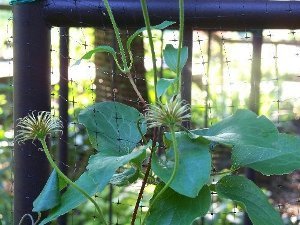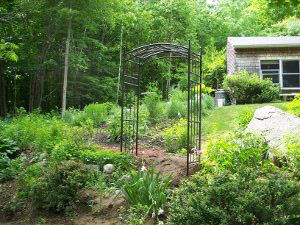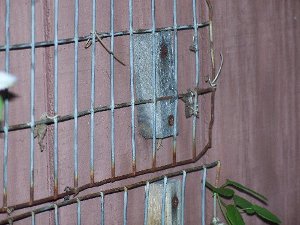Supporting the Habit:
How to Help Your Clematis Grow Straight and True
You've finally admitted it: you have a problem. You just can't have enough clematis. You understood you no longer had control the day you found a new variety, had no place to put her and bought her anyway. Now, she languishes in her pot, desperate to grow and climb and you have nothing to offer her.
Don't worry; we're here for both of you to offer the support you need! There are plenty of options, and neither you nor your clematis need to suffer anymore. In fact, we can even help you find room for your current and future clematis to climb. Doesn'that just give whole new meaning to "supporting the habit"?

One important thing you need to know: Clematis climb by wrapping their leaf stems around small things. They do not cling, like Boston Ivy or Trumpet Vine do. Thus, they will NOT climb a building - or a rock wall - unless you provide something for them to wrap those leaves around. Don't worry - we'll tell you how!
Arbors and Pergolas
Arbors and pergolas are both garden structures tall enough to walk under; add a bench or chair and they are often used as a place to sit. The difference between them is one of scale; think of an arbor as a doorway and a pergola as a hall. Arbors are often (although not always) arched on top while pergolas are usually flat. Both provide excellent space to grow climbing plants.

The obvious benefit to arbors and pergolas is that they are free-standing. There is no need for anything else to stabilize them and they are elegant solutions for people who are already growing clematis on their porch railings, fences, mailboxes, houses and neighbors-who-stood-still-too-long.
In some cases, a little extra help is needed. First, a young Clematis is unable to make the jump from the ground to the first rung of this arbor without a helping hand. Imagine kittens trying to make their way up a steep set of stairs! Fortunately, this is easily overcome by adding a bit of bird setting or wire between the ground and the first horizontal rung on the structure. Second, while some arbors may have lots of small, decorative dodads for clematis to cling to, others will not. We often add bird netting or chicken wire to arbors and other structures to make sure there is plenty for clematis to grab!
Obelisks
For those who prefer the three-dimensional look for their beauties, or who just don't have as much space, an obelisk a great choice.

Baby clemtis may also need extra support added to an obelisk. Some will have latticework at the bottom to give the new babies the jump-start they need, but others, like the one pictured, need wire or netting to fill in the gaps between the supports provided by the obelisk.
Also, despite the wishes of many of our customers, you cannot grow a clematis up each side of the obelisk! Too many lovely ladies in too small a space and everyone suffers!
Bird Netting and Wire
The beauty of bird netting is that it is nearly invisible. It does require support however: you'll need something to attach it to, and you will need to staple or otherwise fasten it every few inches to prevent it collapsing under the weight of a full-grown Clematis.

Wire is more easily seen, but is also sturdier. Also, wire works well when growing a climber against a building, as long as the wire is spaced away from the building. This will allow your climbing ladies to get a grip on their way up the surface you choose.
Several of our customers have planted clematis at the base of rock walls so they could climb the walls and cover the rocks. This is an excellent idea, as long as you provide something for the plants to cling to - wire is the ideal choice here, as it is less apt to wear out from rubbing on the rocks.


